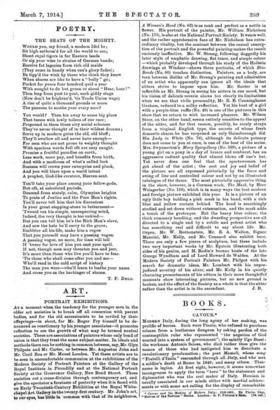ART.
PORTRAIT EXHIBITIONS.
AT a moment when the tendency for the younger men in the older art societies is to break off all connexion with parent bodies, and for the old secessionists to be reviled by their offsprings—in short, for Mr. Roger Fry himself to be de- nounced as reactionary by his younger associates—it promotes reflection to see the growth of what may be termed neutral societies. These are associations of painters whose only bond of union is that they treat the same subject-matter. In ideals and methods there can be nothing in common between, say, Mr. Glyn Philpote and Mr. Carter, or between Mr. Augustus John and Mr. Cecil Rea or Mr. Mouat London. Yet these artists are to be seen in uncomfortable communion at the exhibitions of the Modern Society of Portrait Painters at the Gallery of the Royal Institute in Piccadilly and at the National Portrait Society at the Grosvenor Gallery, New Bond Street. These societies out a cross-division through contemporary art, and give the spectator a foretaste of posterity when it is faced with an Early Twentieth-Century Exhibition at the Royal White- chapel Art Gallery in the twenty-first century. Mr. John's art, to our eyes, has little in common with that of its neighbours.
A Woman's Head (No. 63) is as rank and perfect as a nettle in flower. His portrait of the painter, Mr. William Nicholson (No. 170), is also at the National Portrait Society. It wears well, and the rather apprehensive face of Mr. Nicholson has extra- ordinary vitality, but the contrast between the casual concep- tion of the portrait and the powerful painting makes the result curiously ineffective. Mr. W. Strang, following doggedly his later style of emphatic drawing, flat tones, and simple colour —which probably developed through his study of the Holbein drawings at Windsor—shows three portraits, of which Blue Beads (No. 80) touches distinction. Painters, as a body, are torn between dislike of Mr. Strang's painting and admiration of an artist who apparently can ignore all the ideals that sitters strive to impose upon him. Mr. Sauter is as inflexible as Mr. Strang in seeing his sitters in one mood, but his vision of delicate reverie shows too clearly its limitations when we see that virile personality, Mr. It. B. Cunningliame Graham, reduced to a milky reflection. Yet his bust of a girl with a purple-blue ruffle (No. 49) is one of the pictures in this show that we return to with increased pleasure. Mr. Wilson Steer, on the other hand, seems entirely sensitive to the appeal of the sitter, and for that reason, possibly, he rarely strays from a virginal English type, the secrets of whose fresh domestic charm lie has Surprised as only Gainsborough did. His Lady in White (No. 76), although its delicate potency does not come to you at once, is one of the best of the series. Mrs. Swynnerton's Mary Spieyelbery (No. 189), a picture of a young girl on a pony in a day of breeze and sunburst, has an aggressive radiant quality that almost blows off one's bat. Yet never does one feel that the sportswoman Lae got ahead of the artist ; the zest and joy and belief of the picture are all expressed pictorially by the force and swing of line and controlled colour and not by an illustrated catalogue of the items. The most pictorially aggressive thing in the show, however, is a German work, The Mask, by Herr Weisgerber (No. 118), which is in many ways the best modern and foreign picture exhibited this year. It is a picture' of an ugly little boy holding a pink mask in his band, with a‘ rich blue and yellow curtain behind. The head is searchingly studied and set down without extenuation, and the mask adds a touch of the grotesque. But the heavy blue colour, the thick summary handling, and the dwarfing perspective are all directed to a single end by a subtle and potent artist who has something real and difficult to say about life. Mi. Orpen, Mr. W. Rothenstein, Mr. E. A. Walton, Signor Mancini, Mr. Kelly, and Mr. Connard also exhibit here. There are only a few pieces of sculpture, but these include two Tell important works by Mr. Epstein illustrating both sides of his genius, and M. Rodin's bronze busts of the late George Wyndham and of Lord Howard de Walden. At the Modern Society of Portrait Painters Mr. Pbilpot with his search for dramatic ideas, Mr. Lambert with his unpre- judiced scrutiny of his sitter, and Mr. Kelly in his quietly charming presentments of his sitters in their more thoughtful moments show interesting pictures, but no new ground is broken, and the effect of the Society as a whole is that the sitter
rather than the artist is in the ascendant. J. B..














































 Previous page
Previous page